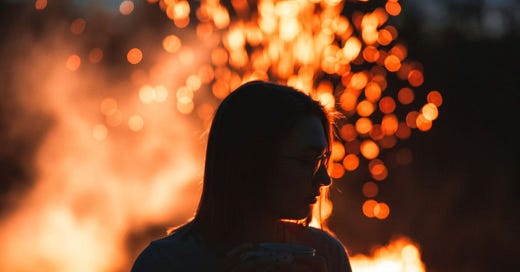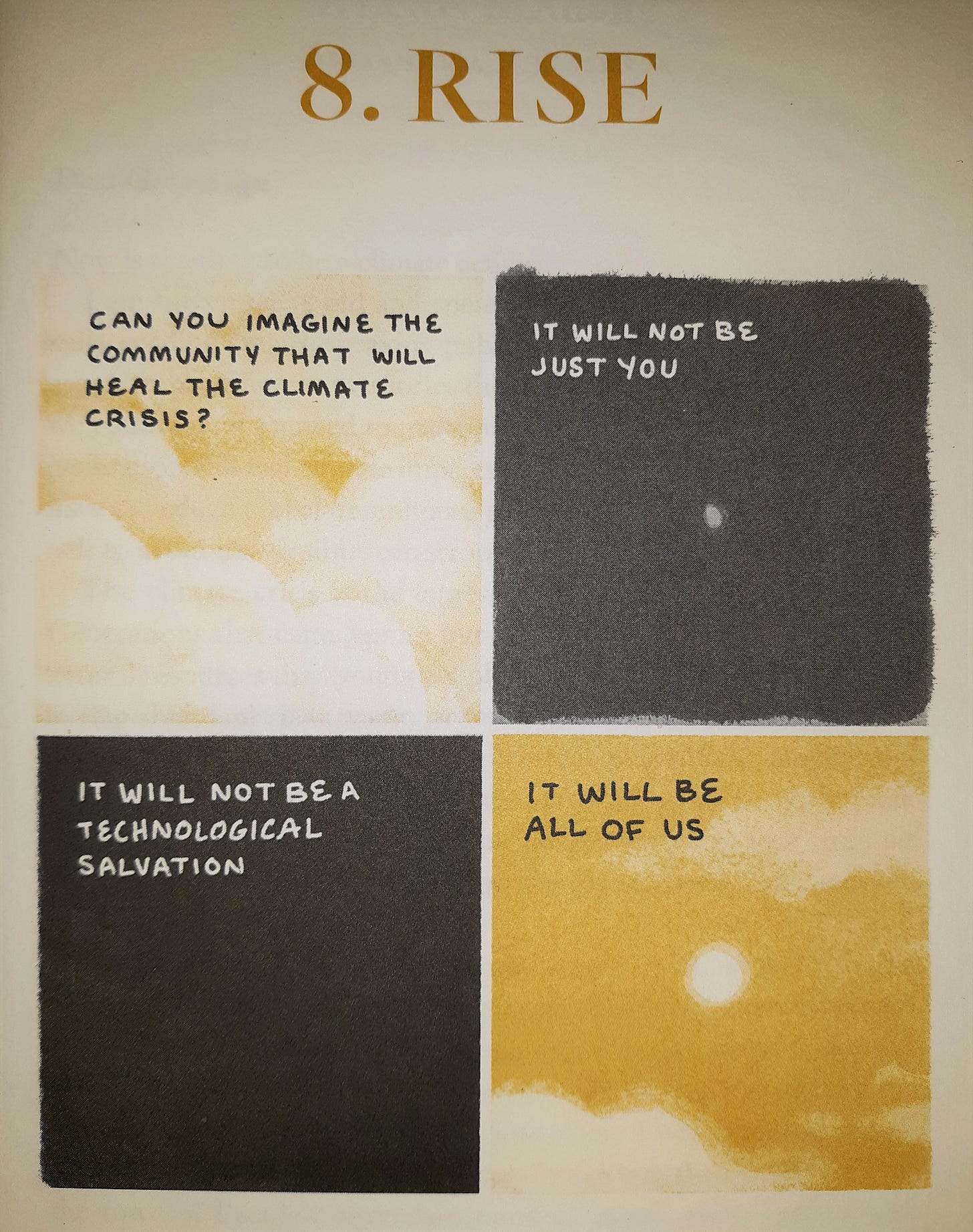Climate crisis meets female energy. Spark! Boom!
An inspiring book by women promotes connection and creativity to solve climate challenges. After the dire UN report on climate change, what happens next?
You’re at Mother E, a free, twice-a-month newsletter telling the stories about our connections with other species in a changing world. You can read more posts here. Missed the last one? Into the Deep Woods.
KATHARINE WILKINSON, A HIGH-PROFILE CLIMATE STRATEGIST, told Time Magazine about her motivation for her work. Not surprisingly, she was inspired by her love for this Earth.
"At the age of 16, perched on a ridge in western North Carolina, I scrawled these words into a handbound journal: Want to help the world. Be connected with the Earth. Change the way I live.
My mother has always called the Appalachians "wise old mountains," not as tall or dramatic as their younger brethren out west but sage and powerful…I recall a steadiness of hand as I recorded my clarity and commitment in that moment. It has stayed with me for longer than two decades, but like many moments of inward truth-telling, it prompted more searching than it supplied answers. But, what can I do? How, where, and with whom?"
Katharine Wilkinson, Climate Strategist, Author and contributor to NY Times bestseller book Drawdown
Wilkinson is the co-author, along with Ayana Elizabeth Johnson, of the 2021 book All We Can Save- Truth, Courage, and Solutions for the Climate Crisis. It's an anthology of all-female voices raised in chorus to the task of healing the climate crisis and its twin disruptor of social injustice.
I was touched and inspired by the myriad voices and paths these passionate women walked in their efforts. The book includes essays, poetry, and visual art from teens up through grandmothers. The book's title was inspired by the poem below:
My heart is moved by all I cannot save:
so much has been destroyed
I have to cast my lot with those
who age after age, perversely,
With no extraordinary power,
reconstitute the world.
Adrienne Rich
The climate movement needs to involve all of us now if we are to have a chance. The contributors to this book represent a diversity of voices: scientists, journalists, farmers, activists, teachers, lawyers, writers, innovators, policy-makers, designers, and artists.
The dire message of the latest United Nations IPCC climate report released August 9, 2021, is that we are in "code red." Here is a cogent summary of that report from 350.org. Without immediate reduction of fossil fuel use (a halving by 2030 and additional halving by 2040) and the halt of biodiversity losses, all life on Earth faces a painful and possibly unlivable future. Even with massive action on a wide scale, there will still be harsh years ahead due to the delayed effects of ocean and planetary warming. But every fraction of a degree of rising temperature we can avoid offers more hope.
Perhaps climate disruption can be viewed as an opportunity to correct course so our human species can learn balance.
What calls us into more caring and action? Fear and anger can be insufficient or unpromising motivators for many people. Love and inspiration often call us forward more powerfully. What do you love that you don't want to see vanish or suffer? Maybe it's a special place or animal species. Perhaps it's your children, family members, friends, your own self. Maybe it's all of the above.
As the All We Can Save book jacket says, this new climate movement is "rooted in compassion, connection, creativity, and collaboration." It’s a living, evolving, very human movement.
The climate crisis is a systemic problem that affects every aspect of our lives now. It impacts our feelings of security, our food crops, our homes, transportation, health, human justice, and much more. It has imperiled millions of other species too. We need system-wide changes. But how do we bring desperately needed change unless we can involve everyone?
Waiting for governments to solve matters will not save us, as they are too slow-moving and often not creative enough. Besides, governments are comprised of people and are only moved by the demands of the populace. That’s one role for us, as demanders of change. There are many other meaningful roles too.
It's time to invite more participation in imagining the future we want to see. All are welcome— men too of course! Rather than just lamenting a failing system, we can co-create a new system that works better for all living beings. Something can be saved, even with a future of uncertainty and anticipated losses.
I offer some thoughts here from others’ experiences and mine on how to be a better supporter of the Earth and your own well-being.
1. Feel the feelings and name them.
We are all emotional beings living in a physical body. Before I started climate work in 2018, I muddled about for several months, feeling alarmed, unsettled, and grieving the magnitude of the destructive forces in the world. I felt like my one voice had little impact, yet doing nothing felt even worse.
The first thing that helped me was clarifying my feelings about why I was disturbed. Feel the emotions and name them. It's OK to grieve or rage about the tragedies and losses occurring in the world. That’s normal. We can't move forward until we have given those feelings expression. Your reactions may serve to point you in a particular direction.
2. Identify what matters most to you, then find others who share those goals.
To love something is to want to protect it, promote it, prioritize it. But before jumping into action, it's necessary to pause and reflect. What do you love most about this world? What truly matters to you? Is there an alignment between your priorities and your time and effort? If not, what can you let go of to add something vital you care about more?
I became involved with a couple of climate groups, but the political side of activism did not inspire me to keep going. The news promoted tech solutions for the climate crisis. It also focused on reducing fossil fuel use (yes, very urgent), but I felt more worried about the biodiversity crisis of animals and plants. What use is technology if the underlying life systems on which we depend are falling apart? Support of biodiversity and living ecosystems became my goal. Once I became clear on that, opportunities started appearing.
I organized, with the help of two friends, a community Earth Day that introduced me to key people who aligned with my goals. I also joined a land trust board to work on local conservation and habitat protection. But actions don't have to be around organizing or joining something. They can be smaller actions or lifestyle changes.
There are thousands of ways to make a positive difference in reducing fossil fuel use, lowering consumption, increasing community cohesion, restoring lands and ecosystems, and promoting sustainable ways of living.
16 Ways to Take Action on climate (from the U.N.)
Reduce Plastic Use in 10 Days (easy video course from Commune)
Become a Backyard Carbon Farmer with regenerative gardening.
Donate monthly to a climate or environmental non-profit of your choice, like Project Drawdown, the world’s leading resource for climate solutions.
Meet up with neighbors or friends to explore ways to make your homes more climate-friendly.
Share tools, share rides, share books— all ways to reduce consumption.
Get outside with a local group that has an environmental focus— clean up beaches or parks, plant trees, observe and monitor wildlife, volunteer with a land trust, etc.
Anything in support of life can be considered a climate action these days. Taking action with others can bring joy and feelings of connection. Charles Eisenstein, an author and cultural philosopher, names a "disease of loneliness" in our culture. Becoming more involved can lift spirits, foster connection, and also improve communities.
3. List the talents, abilities, and interests you can bring to the effort.
Start with what you like to do that might dovetail with a need. Doing more of it can then be fun, engaging, or broaden your skills. Next, look at what you love and want to support. Working towards a goal you believe in, especially when done with others, can bring satisfaction.
When I did this exercise, I listed reading, writing, research, working with plants, and being outside in nature. I saw that the reading, writing, and research put me into the category of a communicator. I felt there was a shortage of writing about the intelligence of other species, their connections to us, and tying that into the biodiversity crisis. Mother E was born.
Your path to more action for Earth will be unique to you. It's waiting for your special blend of talents, time, and interests. Give it a try.
"Whatever you do, or dream you can do, begin it. Boldness has genius, power, and magic in it."
Johann Wolfgang Von Goethe
Gather. Imagine. Act.
In this time of burning forests, melting glaciers, and widespread extinction, we need to tap into the wisdom of others to navigate our way through smoky skies. David G. Haskell, in his thoughtful essay, Eleven Ways of Smelling a Tree (Emergence Magazine, Vol. 2) offers the following observation about fire and forests calling us into action.
"Wood smoke has always called us into community, opening human possibility. The modern crisis of forest burning does the same, but on a scale unknown to all previous peoples. It is no longer a campfire or hearth calling us, but the ancient forests themselves, as they blaze and die: Gather. Imagine. Act."
David G. Haskell, biologist, author and professor
Coincidentally, "GAther-Imagine-Act" can be summed up as Gaia, a word used for the Earth's own living, intelligent presence.
Gather with a friend or a group, discuss your thoughts, fears, and feelings about our rapidly changing world.
Imagine the type of sustainable living systems we want to have in our future: cities that grow food, buildings that support health, clean transportation, communities where all people can thrive, ample spaces for nature to grow and roam wild.
What does your family, neighborhood, or region need to improve life for both humans and other species? It may be something significantly small or something inspirationally large. Identify the discrepancy between where you are now and where you want to be. That gap is the place that calls us to action.
Act as if your life depended upon it. See where you can place your mind, money, hands, or body in service to restoring our planet.
The chorus of women’s voices from the All We Can Save book tells us it's time to give birth to a new and improved world that values the lives of all humans and all species.
What will save us is a generous re-imagination of our way of living and a joining with others to co-create that better world.
"The greatest breakthroughs of the 21st century won't occur because of technology; they will occur because of an expanding concept of what it means to be human."
Megatrends author and futurist John Naisbitt
As always, thanks for reading. Feel free to share on social media with the share button.
I love to hear your thoughts! What motivates you to do something to repair our climate? Or what actions would you like to start? Leave a comment above or reply to this email to reach me privately. I’m on Twitter @RobinApplegarth




